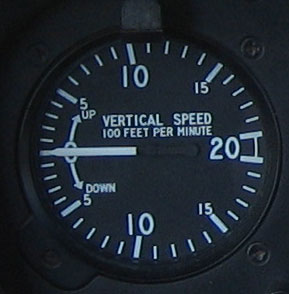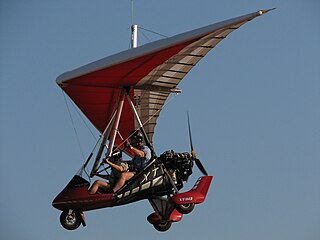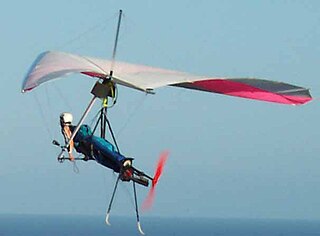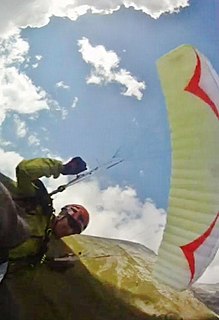
Hang gliding is an air sport or recreational activity in which a pilot flies a light, non-motorised foot-launched heavier-than-air aircraft called a hang glider. Most modern hang gliders are made of an aluminium alloy or composite frame covered with synthetic sailcloth to form a wing. Typically the pilot is in a harness suspended from the airframe, and controls the aircraft by shifting body weight in opposition to a control frame.

Unpowered aircraft can remain airborne for a significant period of time without onboard propulsion. They can be classified as fixed-wing gliders, lighter-than-air balloons and tethered kites. This requires a trajectory that is not merely a vertical descent such as a parachute. In the case of kites, lift is obtained by tethering to a fixed or moving object, perhaps another kite, to obtain a flow of wind over the lifting surfaces. In the case of balloons, lift is obtained through inherent buoyancy and the balloon may or may not be tethered. Free balloon flight has little directional control. Gliding aircraft include sailplanes, hang gliders, and paragliders that have full directional control in free flight.

A fixed-wing aircraft is a flying machine, such as an airplane, which is capable of flight using wings that generate lift caused by the aircraft's forward airspeed and the shape of the wings. Fixed-wing aircraft are distinct from rotary-wing aircraft, and ornithopters. The wings of a fixed-wing aircraft are not necessarily rigid; kites, hang gliders, variable-sweep wing aircraft and airplanes that use wing morphing are all examples of fixed-wing aircraft.

Paragliding is the recreational and competitive adventure sport of flying paragliders: lightweight, free-flying, foot-launched glider aircraft with no rigid primary structure. The pilot sits in a harness suspended below a fabric wing. Wing shape is maintained by the suspension lines, the pressure of air entering vents in the front of the wing, and the aerodynamic forces of the air flowing over the outside.

Ultralight aviation is the flying of lightweight, 1- or 2-seat fixed-wing aircraft. Some countries differentiate between weight-shift control and conventional 3-axis control aircraft with ailerons, elevator and rudder, calling the former "microlight" and the latter "ultralight".

A variometer – also known as a rate of climb and descent indicator (RCDI), rate-of-climb indicator, vertical speed indicator (VSI), or vertical velocity indicator (VVI) – is one of the flight instruments in an aircraft used to inform the pilot of the rate of descent or climb. It can be calibrated in metres per second, feet per minute or knots, depending on country and type of aircraft. It is typically connected to the aircraft's external static pressure source.

The Rogallo wing is a flexible type of wing. In 1948, Francis Rogallo, a NASA engineer, and his wife Gertrude Rogallo, invented a self-inflating flexible wing they called the Parawing, also known after them as the "Rogallo Wing" and flexible wing. NASA considered Rogallo's flexible wing as an alternative recovery system for the Mercury and Gemini space capsules, and for possible use in other spacecraft landings, but the idea was dropped from Gemini in 1964 in favor of conventional parachutes.

Francis Melvin Rogallo was an American aeronautical engineer inventor born in Sanger, California, U.S. Together with his wife, he is credited with the invention of the Rogallo wing, or "flexible wing", a precursor to the modern hang glider and paraglider. His patents were ranged over mechanical utility patents and ornamental design patents for wing controls, airfoils, target kite, flexible wing, and advanced configurations for flexible wing vehicles.
Kite types, kite mooring, and kite applications result in a wide variety of kite control systems. Contemporary manufacturers, kite athletes, kite pilots, scientists, and engineers are expanding the possibilities.

An ultralight trike is a type of powered hang glider where flight control is by weight-shift. These aircraft have a fabric flex-wing from which is suspended a tricycle fuselage pod driven by a pusher propeller. The pod accommodates either a solo pilot, or a pilot and a single passenger. Trikes grant affordable, accessible, and exciting flying, and have been popular since the 1980s.

Hang gliding is an air sport employing a foot-launchable aircraft known as a hang glider. Typically, a modern hang glider is constructed of an aluminium alloy or composite-framed fabric wing. The pilot is ensconced in a harness suspended from the airframe, and exercises control by shifting body weight in opposition to a control frame.

A foot-launched powered hang glider (FLPHG), also called powered harness, nanolight, or hangmotor, is a powered hang glider harness with a motor and propeller in pusher configuration. An ordinary hang glider is used for its wing and control frame, and the pilot can foot-launch from a hill or from flat ground, needing a length of about a football field to get airborne, or much less if there is an oncoming breeze and no obstacles.
Gliding flight is heavier-than-air flight without the use of thrust; the term volplaning also refers to this mode of flight in animals. It is employed by gliding animals and by aircraft such as gliders. This mode of flight involves flying a significant distance horizontally compared to its descent and therefore can be distinguished from a mostly straight downward descent like with a round parachute.

A glider is a fixed-wing aircraft that is supported in flight by the dynamic reaction of the air against its lifting surfaces, and whose free flight does not depend on an engine. Most gliders do not have an engine, although motor-gliders have small engines for extending their flight when necessary by sustaining the altitude with some being powerful enough to take off self-launch.

Gliding is a recreational activity and competitive air sport in which pilots fly unpowered aircraft known as gliders or sailplanes using naturally occurring currents of rising air in the atmosphere to remain airborne. The word soaring is also used for the sport.

A glider or sailplane is a type of glider aircraft used in the leisure activity and sport of gliding. This unpowered aircraft can use naturally occurring currents of rising air in the atmosphere to gain altitude. Sailplanes are aerodynamically streamlined and so can fly a significant distance forward for a small decrease in altitude.
Unpowered flight is the ability to stay airborne for a period of time without using any power source. There are several types of unpowered flight. Some have been exploited by nature, others by man, and some by both.

Speed-flying and speed riding are advanced disciplines of paragliding that use a small, high-performance paraglider wing to quickly descend heights such as mountains. Speed flying and speed riding are very similar sports; speed flying is when the speed wing is foot-launched, while speed riding is a winter sport done on skis.
The Purcell Flightsail or Flight Dynamics Flightsail is an experimental towed glider by Thomas H. Purcell, Jr. He sold plans in several publications for the tow-launched hung-mass controllable kite-glider. He flew first off water in late 1961 and then arranged things for off-land and landing on land. His efforts would find similarity echo later in early 1963 by the SkiPlane of Mike Burns.














